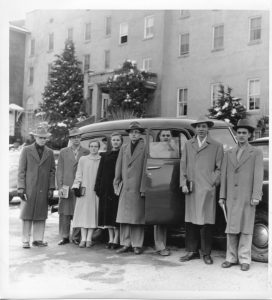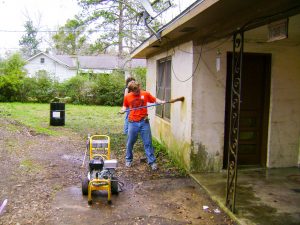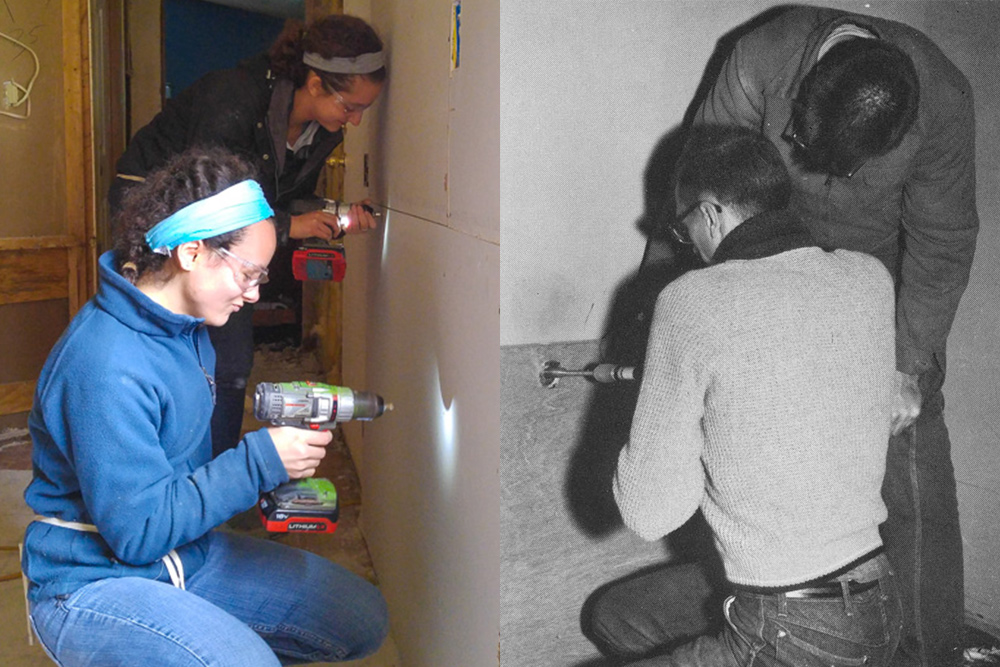From March 6-10, 2017, Eastern Mennonite University Y-Serve sends four student groups on service learning trips. A special chapel Friday, March 3, at 10 a.m. in Lehman Auditorium, will offer prayers for their safe journeys.
Read on to learn more about the history of YPCA/Y-Serve.
***
If asked to identify the most influential student organization in Eastern Mennonite University’s 100-year history, the answer is easy: the Young People’s Christian Association, known popularly as YPCA or the Y.

For many years, the student body and YPCA were one and the same: if you were a student at what was then called Eastern Mennonite School in its earliest years, you were a member of the YPCA.
The organization continues today under a new name: Y-Serve. This recent change, in spring 2016, has puzzled some alumni, but advisor and Campus Pastor Brian Martin Burkholder says the mission and vision of the organization remain the same. “The new name reflects more about the organization to a new generation of students that doesn’t necessarily know the acronym,” he said. “The organization’s mission of taking ministry into neighborhoods, communities, retirement homes and other places hasn’t changed. The Jesus-centered focus continues.”
Under its charter, Y-Serve still occupies a unique place as one of two student organizations on campus (the other is the Student Government Association). In contrast to clubs, Y-Serve “provides resources, opportunities for service projects and service-related trips to all students. That’s a key difference.”
Another difference: the old structures of commissions and committees are gone, replaced by “a more responsive, less obligation-driven structure,” he says.
Burkholder, who has advised the group for 12 of the nearly 14 years he’s been at EMU, likens the need for change to a “big church that spends so much time trying to fill committees that it hinders responding to God’s call in the community … this structure will allow members more time to serve and do service and ministry instead of working to fill the commissions.”
The new Y-Serve continues the important legacy of the YPCA on campus. “There’s a rich history of contributing to this institution’s vibrancy and Christian character,” Burkholder said.
That legacy was honored at an 85th anniversary celebration, in which Carmen Schrock-Hurst ’81, who was co-president (with Harry Kraus ’82) from 1980-81 and is now an instructor in the Bible and Religion department, eloquently linked the YPCA of old to its modern membership.

Perhaps at this anniversary celebration it behooves us to ask ‘Why?’ of the Y. Why, when there is pressure to study and work to pay the tuition bills, and infinite opportunities to socialize and participate in extra- curricular activities – why do students consistently continue choose to give of their time and money to keep alive the Y?
The answer, she said, is at the heart of what makes EMU unique: a belief in God’s word and the call to find one’s life by losing it. Y participants have exemplified and continue to model the “desire to have education be rooted in the real world and not tucked away in an ivory tower of isolationism,” she said.
Decades of Christian education and witness
From its first meeting on March 17, 1922, the group was involved in all aspects of student life on campus, mobilizing student cooperation to “strengthen the spiritual life of the school; to promote growth in Christian character, fellowship and aggressive Christian work; and to train its members for Christian service and to teach them to devote their lives to Jesus Christ.”
The organization enveloped all students and infused Christian devotion into every aspect of student life, from planning on-campus ministry activities and social activities to forming a quasi-student government and initiating fundraising efforts to support the school. YPCA also was active in off-campus ministry and service learning trips, which often served the dual purpose of weekend social activities.
Impact over the years
Here’s just a sampling of the impact YPCA had on EMC/EMU:

—From 1922-46, YPCA published the student handbook, a combination rulebook, welcome packet, calendar, and social guide.
—Fund drives provided financial backing for campus buildings, social activities and the evangelizing Christian witness. Examples include a 1926 fundraiser of $1,200 [$16,200 in 2016 dollars] that helped build a new chapel in the south annex of the Administration Building. Nearly 40 years later, in 1960, a spring fund drive raised $4,746 [$38,650 in today’s dollars], with pledges coming from 330 students, faculty and staff. The planned budget breakdown for usage of that money was “42% for city evangelism, 25% for rural evangelism, 10% for the foreign student fund, and 6% for institutional evangelism. The remaining 17% will go for literature evangelism, itinerary evangelism, and miscellaneous expenses.”
—In 1938, the “Tract Distributors” would, once a month, place a tract on every doorstep in Harrisonburg. It took 36 students a full day to distribute the 1,700 tracts.
—At least 20 local congregations were either begun or significantly boosted by YPCA students: Beldor, Big Spring, Broad Street, Crossroads, Elkton, Gospel Hill, Morning View, Mt. Hermon, Mt. Jackson, Mt. Vernon, Ridgeway, Staunton, Valley View, and Zion Hill are just a few.
—The 1950 Annual Report listed “129 conversions” and “5,690 service opportunities,” with 111 student leaders and two YCPA-owned cars.
—YPCA activities and structure provided the foundations for three now-separate student organizations: Campus Activities Council, Celebration, and Peace Fellowship. Many other clubs should also trace their organization’s beginning to the Y, when it filled their roles in slightly different ways when it was the only student led social organization for years.

—Well before the cross-cultural experience became a graduation requirement, many students traveled to new areas with YPCA. The 1967-68 report states “there is an increasing awareness among student groups that many times a more practical experience than just ‘book learning’ is necessary in order to relate well to the world.”
—In the 1980s, the main ministries were the Saturday Adoption Program, Y-Church, Western State mental hospital outreach, Wilson Rehabilitation, Gospel Outreach Teams, Work Teams, and Jail Ministry.
—In the 2000s, YPCA launched and strengthened partnerships with ministries including the Virginia Mennonite Relief Sale, Virginia Mennonite Retirement Center, Sharing with Appalachian People, Mennonite Disaster Service, Jubilee Partners, Alterna Community and area Kid’s Clubs.
—In 2016, Y-Serve paired with Gospel Choir and the Black Student Union to fund and coordinate a“Civil Rights Tour” through the American South during Spring Break. Additionally, four other Y-Serve groups traveled to work sites.
Junior Caleb Schrock-Hurst contributed research and analysis to this article.
